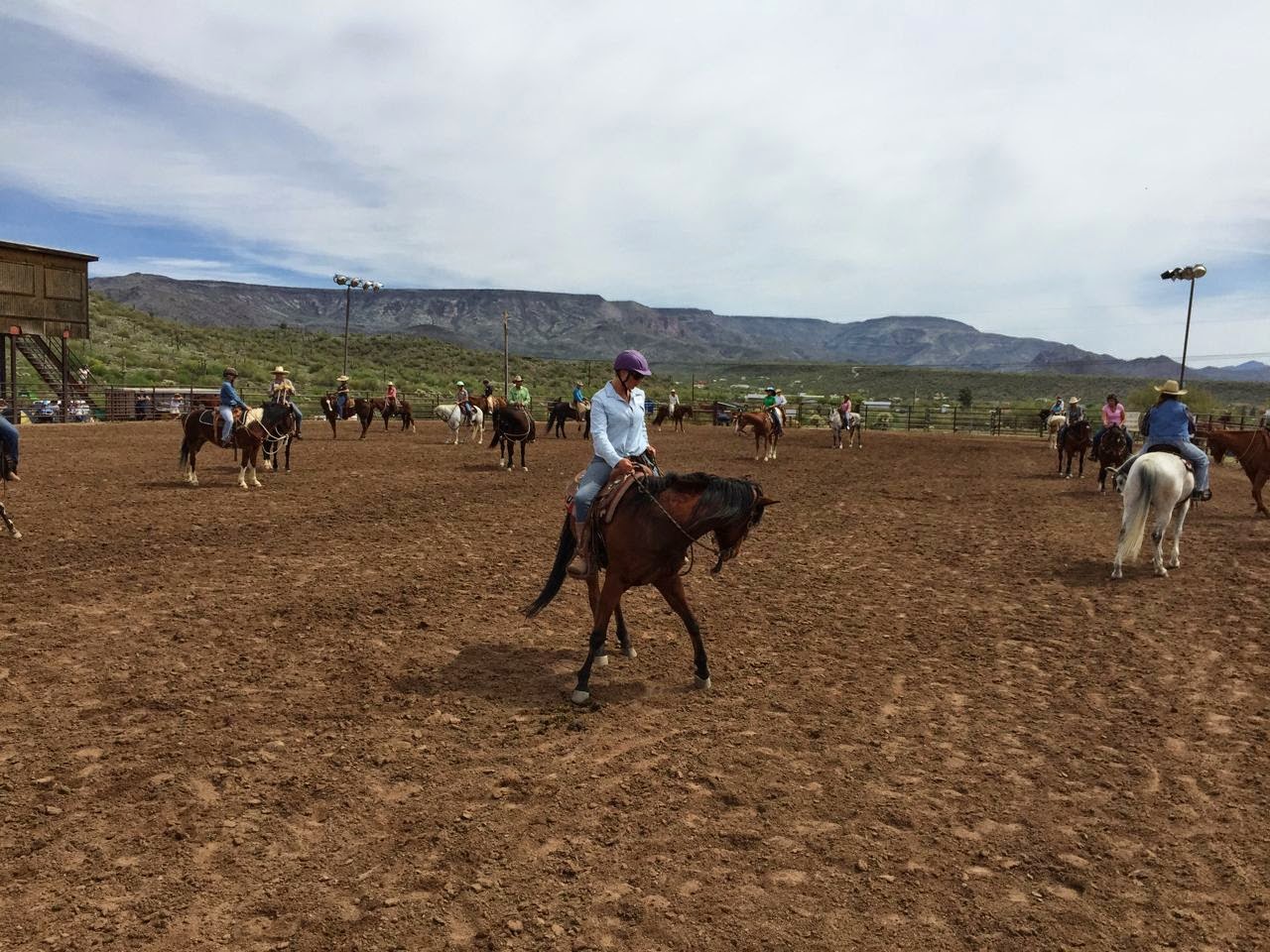 |
| Suz & Drifter, Sierra (Junior not pictured), Buck & Arc, Hailey (Quincy not pictured), Paul & Cinco |
As with all of the clinics, in the first hour, we listened to Buck's stories. Buck talked about the young snaffle bit horse he was riding and got him working some serpentines and circles. The first few minutes Buck was on Big Swede, the horse scooted out sideways in a nearly identical maneuver that chucked me off the back of Bravo in January. I immediately took note of Buck's balance and how short his reins were. My reins were too long and I didn't have the balance point that Buck had. I tried in vain to one-rein stop to the right, but found the ground instead as Bravo exited left. Buck told me to keep my weight in the left stirrup. "You'll need that right leg to help the hindquarters around, so you don't want your weight there." He added that I need to keep my reins short and very wide, but with my hands forward so contact isn't on the bit unless I bend the horse...until I know the horse is in a better mindframe. Sounds simple enough. (I was thankful for the advice for my post-clinic ride on Bravo, because I needed it and stayed in the saddle.)
Among other lessons Buck focused on this year was "the reach", which was used over the course of the clinic to help my horse wait for me (rather than tossing his head) when working a cow. The 2-part exercise has two positions. Its benefits include teaching a horse to wait (not anticipate), and teaches the rider to be more aware of the feet and positioning.
1. Ask your horse to bend his head around approximately 90-degrees (for this example, to the right).
- When you reach for the horse's head, slide your hand down the right rein. Bring the rein out and around as your horse bends his head. Your elbow will end up at your side and your right hand in front of the saddle, to the right of the horn.
- Your horse shouldn't move his feet. If he does, wait and go back to step one.
- You want your horse's head and ears level. You want lateral and longitudinal flexion. If his head is uneven, he is unbalanced with too much weight on the outside shoulder. If the poll is too low, there is too much weight on the front end.
- You want to practice this (don't drill on it...get something good and then move on, but keep practicing) until you can "bet your life on it" with your horse light and willing to respond.
2. Ask your horse to reach his right foot out to the right.
- Bring your right elbow back and slide the rein and your hand to where your elbow was in position 1...about six inches away from your hip.
- You will use the outside supporting left rein gently. A supporting leg can be developed when the horse is reaching properly.
- Your horse should take one step...a good reaching step to the right. Good timing would be for your horse to take the step as you are moving the rein out to position 2.
- You will release as the reaching foot lands. "Hook the rein to the foot...pick the foot up and move it, then set it down."
- If your horse moves forward after the first step, back him up, releasing when he's soft.
 |
| Sierra and Junior practicing "The Reach" from position 1... |
 |
| The Reach position 2 |
Eventually, you will not need to bend the horse's head as much, but this is a start for developing proper flexion through a turn. I went back to step one with Drifter, teaching him to wait on me.
"You're gonna need this with that horse." Buck said to me, noting that Drifter was trying really hard to be in position on a cow, but he tossed his head and pushed through my reins to do it. I asked if I should move Drifter back to the snaffle bit, but Buck seemed to think I could get it done with where I'm at in the hackamore (bosal hackamore, to clarify). At the end of the four days, I had better awareness of positioning and much more focused horse when things got fast in cow working. Certainly room to grow, but it was much better.
 |
| Day 1 |
 |
| Day 2 |
 |
| Day 3 |
 |
| Day 4 |
This year, Buck often mentioned "the rectangle" of real estate shared between you and your horse. His message is consistent with all participants from clinic to clinic (hearing the same messages when auditing Del Mar).
We had pretty good seats on a raised patio in Del Mar, sitting us right behind Buck's place in the cow-working rodear. He told participants when their horses were outside their rectangles. Sometimes the horse was ahead of the rider...sometimes they were behind.
I took a quiet moment to ask Buck a question about the rectangle.
"Is the rectancle nose to tail?"
"I'm not sure what you mean." Buck said.
"Is it the whole horse from nose to tail or is the rectangle the horse's four feet?" I tried to specify.
"It's the whole horse." He said. "When you get really good at this, you will be able to keep your horse within inches of your rectangle. Some people's rectangles are feet, or yards, or an entire arena."
My rectangle isn't as big as it used to be...but I remember needing an arena. Thank you for the reminder!
Next chance for continuing education will be Paul Dietz's clinic in July in Big Bear. Until then, I am going to practice reaching.
great horses.......................
ReplyDelete